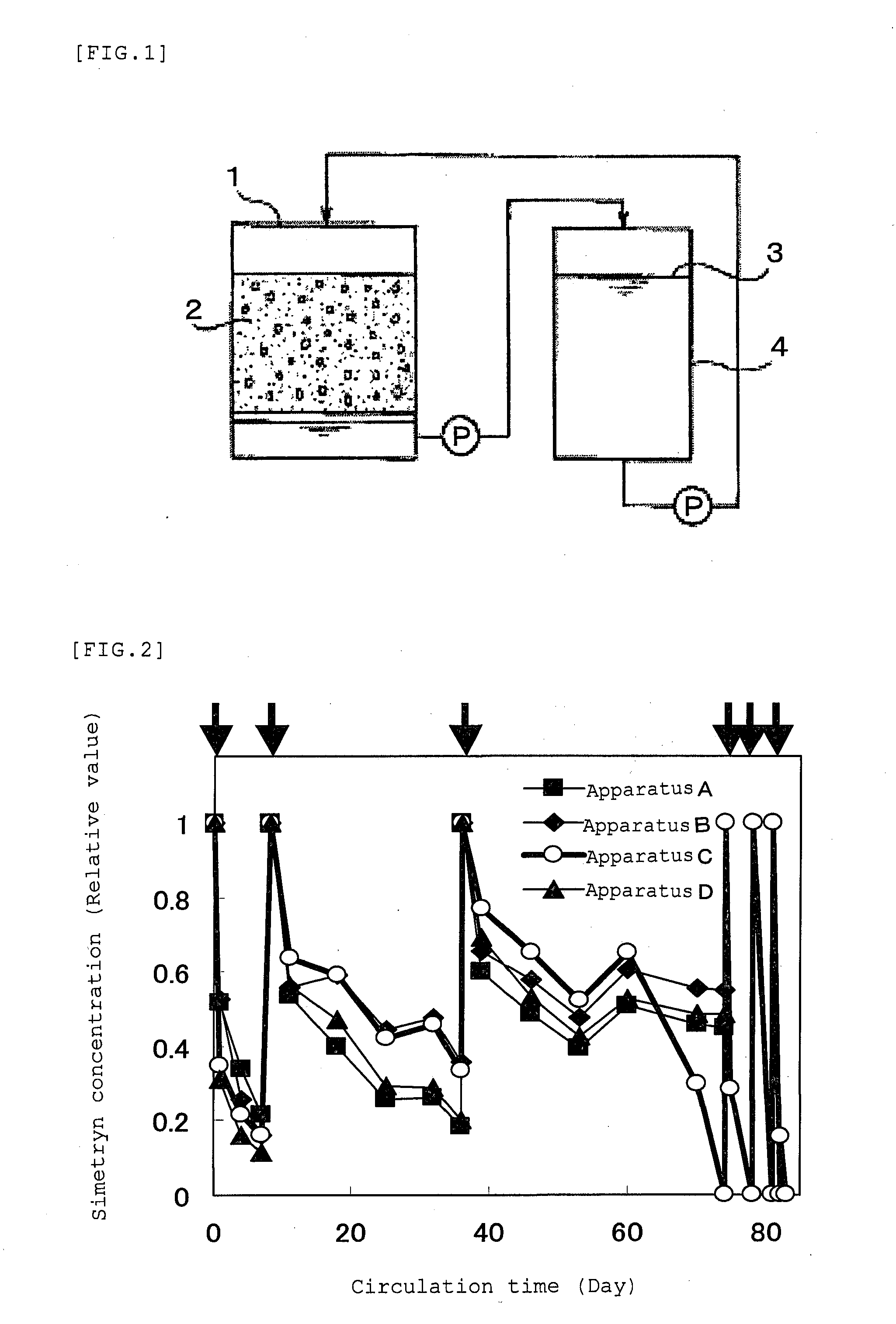Novel microorganism capable of microbially decomposing chloro-, methylthio- and methoxy-triazine agrichemicals
- Summary
- Abstract
- Description
- Claims
- Application Information
AI Technical Summary
Benefits of technology
Problems solved by technology
Method used
Image
Examples
example 1
Isolation of Strain MTD22
[0098]The present inventors have isolated a Nocardioides sp. strain MTD22 as a novel bacterium according to the present invention capable of decomposing a methylthiotriazine, a chlorotriazine, and a methoxytriazine in the following manner. As shown in FIG. 1, 30 to 50 g of soil was placed in a soil layer tank 1 to form an enriching soil layer 2. Then, 200 mL of a sterilized inorganic salt medium containing an appropriate amount of simetryn as a carbon and nitrogen source was pumped out of a solution storage tank 4 and circulated as a circulating solution 3 through the enriching soil layer 2. The composition of the inorganic salt medium used is shown in the following Table
TABLE 4Composition of Inorganic Medium 2MgSO4•7H2O200mgK2HPO41000mgFeSO4•7H2O50mgCaCl220mgMnCl2•4H2O20mgNa2MoO4•2H2O1mgWater1000mL
[0099]Four sets of the apparatus shown in FIG. 1 were prepared. The circulating solution was circulated in each of the apparatuses, and the concentration of simet...
example 2
Bacteriological Studies of Strain MTD22
[0103]In order to determine the taxonomic position of the strain MTD22 isolated in Example 1, morphological properties, growth on medium, physiological properties, and biochemical properties of the strain MTD22 were analyzed at NCIMB Japan. As a result, the strain MTD22 had the following bacteriological characteristics.
[0104]A. Morphological characteristics (culture medium: R2A agar (manufactured by Difco), incubation temperature: 30° C., incubation time: 48 hours)
[0105](1) Cell morphology: cocci
[0106](2) Size: 1.0 to 1.2 μm
[0107](3) Spore formation: None
[0108](4) Mobility: None
[0109]B. Colony morphology (culture medium: R2A agar (manufactured by Difco), incubation temperature: 30° C., incubation time: 48 hours)
[0110](5) Colony diameter: 1.0 mm
[0111](6) Color: Slightly yellow
[0112](7) Shape: Circular
[0113](8) Elevation: Lens shape
[0114](9) Margin: Entire
[0115](10) Surface profile: Smooth
[0116](11) Transparency: Opaque
[0117](12) Viscosity: Butte...
example 3
Decomposition of Methylthiotriazine Compounds, Chlorotriazine Compounds, and a Methoxytriazine Compound Using Strain MTD22
[0151]The present inventors have examined the ability of the strain MTD22 to decompose triazine compounds in the following manner. Twenty milliliters aliquots of an inorganic liquid medium each containing about 1 to 8 mg / L of a methylthiotriazine compound (i.e., ametryn, desmetryn, dimethametryn, prometryn, or simetryn), a chlorotriazine compound (i.e., atrazine, simazine, propazine, or terbuthylazine), or a methoxytriazine compound (i.e., atraton) were dispensed into 100 mL Erlenmeyer flasks. On the other hand, the strain MTD22 was statically cultured on a R2A agar medium at 30° C., and then colonies growing on the agar medium were collected with an inoculating loop and suspended in 1.5 mL of the inorganic medium to obtain a suspension. Then, 100 μL of the suspension was inoculated into each of the aliquots of inorganic liquid medium and cultured on a rotary sha...
PUM
 Login to View More
Login to View More Abstract
Description
Claims
Application Information
 Login to View More
Login to View More - R&D
- Intellectual Property
- Life Sciences
- Materials
- Tech Scout
- Unparalleled Data Quality
- Higher Quality Content
- 60% Fewer Hallucinations
Browse by: Latest US Patents, China's latest patents, Technical Efficacy Thesaurus, Application Domain, Technology Topic, Popular Technical Reports.
© 2025 PatSnap. All rights reserved.Legal|Privacy policy|Modern Slavery Act Transparency Statement|Sitemap|About US| Contact US: help@patsnap.com


